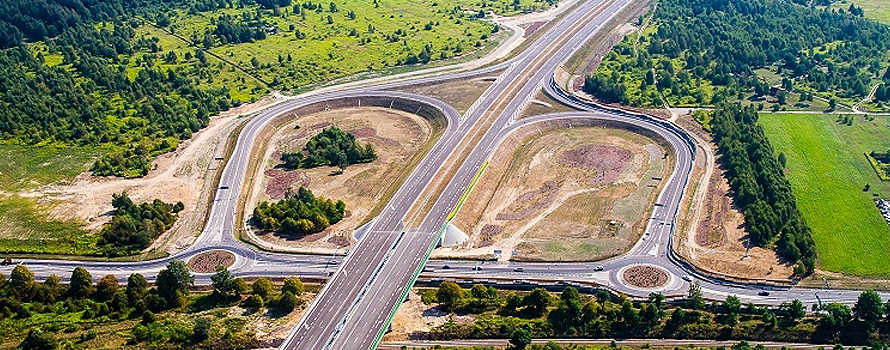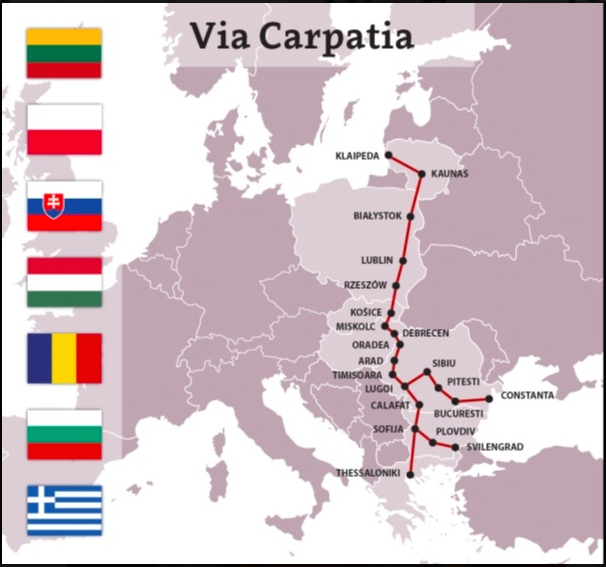A new north-south motorway on the eastern edge of the EU aims to be the entrance gateway to Europe for goods from China.
Seven European countries have joined forces for the project Via Carpatia, a motorway that will run from Lithuania to Romania and Greece, increasing the interconnectedness of the EU's eastern region. Its promoters envisage the infrastructure as part of the new Silk Road, as a gateway to Europe for goods arriving from China and the rest of Asia.

▲Polish motorway section to be part of the project Via Carpatia [Generalna Dyrekcja Dróg Krajowych i Autostrad Oddział w Rzeszowie].
article / Paula Ulibarrena
Via Carpatia is a European route; it is actually an ambitious project interstate motorway linking the Baltic Sea and the Black Sea. The route will start in Lithuania, in the city of Kaunas, then continue through Poland, following the Bialystok-Lublin-Rzeszów route; it will then enter Slovakia to cover the Presov-Kosz section, and in Hungary it will run through Miskolc-Debrecen.
On the territory of Romania, the route will be divided into two directions, one towards the port of Constanta on the Oradea-Arad-Timisoara-Lugoj-Deva-Sibiu-Pitesti-Bucarest-Constanta route and the other penetrating into Bulgaria via the future bridge over the Danube at Calafat-Vidin and with the possibility of extending the project to Greece, in the Mediterranean, at the southern border of the European Union.
The project Via Carpatia was C in 2006, when the transport ministers of Poland, Lithuania, Slovakia and Hungary signed a joint declaration to extend the network trans-European transport network by creating a route to connect these four states along a north-south axis. In 2010, project was joined by Romania, Bulgaria and Greece to extend the new route through their respective territories.
Andrzej Adamczyk, Poland's Minister of Public Works, said in May 2017 that the entire 600-kilometre route of this infrastructure in Poland will be completed by 2025. According to him, Via Carpathia "will allow the full potential of the provinces it passes through to be developed, providing a boost for the poorer regions of eastern Poland and the economies of the area".
The purpose of project is to promote the economic development of the region, providing facilities for the development of small and medium-sized business and the creation of technology parks, which should contribute to the creation of employment and enhance research and innovation.
This initiative currently reinforces other policies that also have the goal development of infrastructures in Eastern Europe, such as the 3 Seas Initiative. But it also opens the door to other more ambitious projects, such as the 16+1 and the new Silk Road, both launched by the People's Republic of China.
Connection with China
The 16+1 mechanism is a Chinese initiative aimed at intensifying and expanding cooperation with 11 EU Member States from Central and Eastern Europe (CEE) and 5 Balkan countries (Albania, Bosnia and Herzegovina, Bulgaria, Croatia, the Czech Republic, Estonia, Hungary, Latvia, Lithuania, Macedonia, Montenegro, Poland, Romania, Serbia, Slovakia, Slovenia) in subject investment, transport, finance, science, Education and culture. In the framework of the initiative, China has identified three possible priority areas for economic cooperation: infrastructure, high technologies and green technologies.
The Riga Declaration, a document issued in November 2017 at the China-ECO summit, sets the roadmap for such cooperation. In the Latvian capital, Chinese Premier Li Keqiang and the leaders of Central and Eastern European countries agreed to enhance cooperation internship and increase people-to-people exchanges. In particular, the leaders reaffirmed their desire to achieve effective connectivity between ports on the Adriatic, the Baltic and the Black Sea, through roads and the use of inland waterways.
"The Adriatic-Baltic-Black Sea port cooperation will be a new engine for China-ECO cooperation," said Liu Zoukiu, researcher of the Chinese Academy of Social Sciences, adding that the combination of Chinese equipment, European technology and ECO markets will be a great model for cooperation between China and these 16 nations.
Trade between China and Central and Eastern European countries reached $56.2 billion in 2015, up 28 per cent from 2010. Chinese investment in these 16 nations exceeded $5 billion, while in the opposite direction investment was $1.2 billion.
issue The data also shows that the number of goods train lines between China and Europe has increased to 39 since the connections began in 2011. 16 Chinese cities regularly operate these convoys to a dozen European cities. Beijing's interest in the CEE countries lies precisely in the fact that they are Europe's gateway to the new Silk Road.
|

The future north-south connection, Baltic-Black/Mediterranean [viacarpatia.eu].
|
The European Gateway to the New Silk Road
The 21st Century Silk Road, which the Chinese government has dubbed One Belt One Road (OBOR), is not an institution with clearly defined rules, but rather a strategic vision: it alludes to the ancient Silk Road, the commercial and cultural link between East and West for more than two millennia. The new route aims to be a connectivity network consisting of maritime and land-based economic corridors linking China and the rest of Asia with the Middle East, Europe and Africa. In this way, OBOR puts continents, oceans, regions, countries, cities, international and regional organisations on contact .
The new diplomatic language appears as a seductive tool of Chinese soft power, exported through the routes of trade and diplomacy that reach the gates of Europe. Evoking the historical framework of harmonious coexistence and mutual cultural enrichment, Chinese officialdom defines the "Five Principles of Peaceful Coexistence" as OBOR's core values: (1) mutual respect for sovereignty and territorial integrity; (2) agreement mutual non-aggression; (3) agreement mutual non-intervention in internal affairs; (4) equality and mutual benefit; (5) peaceful coexistence.
China seeks to diversify its trade routes and partners, opening up new consumer markets. At the same time, it is securing supplies of energy and raw materials. Finally, it is expanding its logistical structure and building a China-centred trade network .
Beijing set up a state investment fund, the Silk Road Fund, in 2014 with a capital of $40 billion, earmarked for One Belt, One Road investments. China insists that such financial institutions are not intended to replace existing ones, but rather to complement and collaborate with them in a spirit of inclusiveness and mutual benefit. However, voices from the United States and the European Union have raised some concerns.
US and EU suspicions
US analysts speak of the Chinese European Century (and warn that as investment and trade with Europe grows, so will Beijing's influence over European policies. Indeed, the Asian Infrastructure Investment Bank (AIIB) already has funds of $100 billion, or 50 per cent of the World Bank's capital.
The 16+1 platform was launched to the chagrin of the EU, which was not consulted on the matter beforehand. Brussels observes a status of dependency on the part of some of the continent's poorest countries, caused by a trade asymmetry in favour of China: trains arrive in Warsaw with tons of Chinese goods, but return half-empty. The creation of infrastructure and new production and distribution centres for Chinese goods sometimes progresses beyond the EU's control. Consequently, EU legislative compliance and even European unity itself may be affected.
For the most part, the national interests of European countries seem to be dominated by the pure logic of Economics and lack strategic vision. They have so far made a common and coordinated EU policy towards OBOR impossible. In the absence of unity, Europe is throwing stones at itself and ironically applying to itself the effective "divide and rule" strategy described by the Chinese philosopher Sunzi 2,500 years ago.
New international order
The international order is changing: OBOR, which in paternalistic embrace now encompasses almost all European countries, presents itself as the Chinese alternative to the West's model that has dominated the world until now.
The US is being replaced as the world's leading Economics and losing its political hegemony to the rise of China. This is demonstrated by the reactions of Washington's staunchest allies in Europe, London and Berlin, in joining the OBOR initiative without much hesitation and despite US warnings.
China proposes to create a new international economic and financial order together with Europe. The most notorious milestone of this close partnership is China's injection of up to €10 billion into the EFSI, a decision agreed between Beijing and Brussels in April 2016, making China the largest investor in the so-called Juncker Plan. Together, they can generate economic growth and the creation of employment by building and modernising infrastructure networks that improve intra-European connectivity. This can facilitate the opening up of European products and services for export to new markets and improve their conditions for entrance to China's own market. Europe can benefit from improved connectivity with other hitherto remote regions.